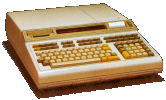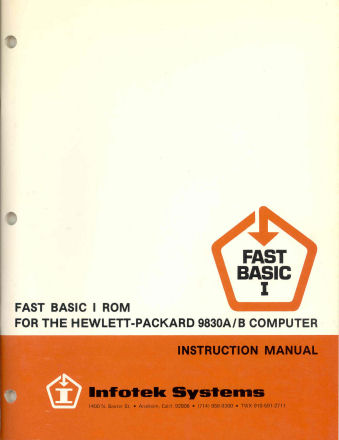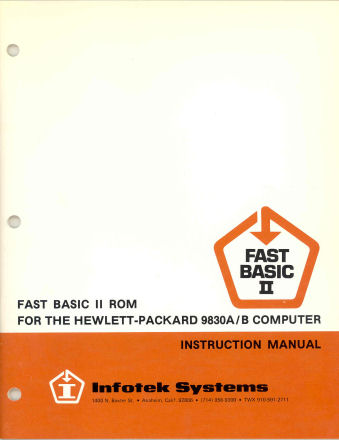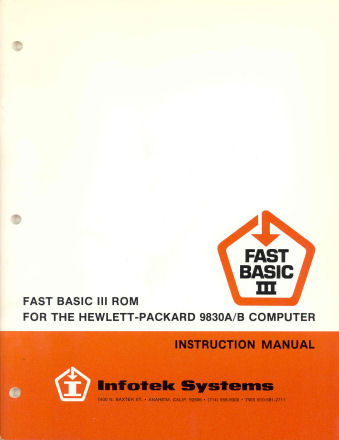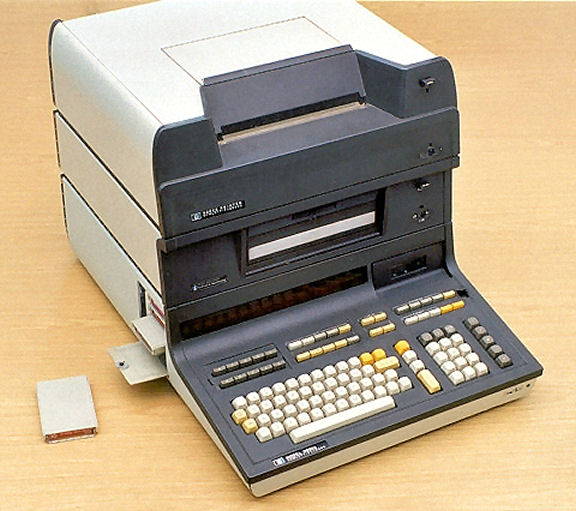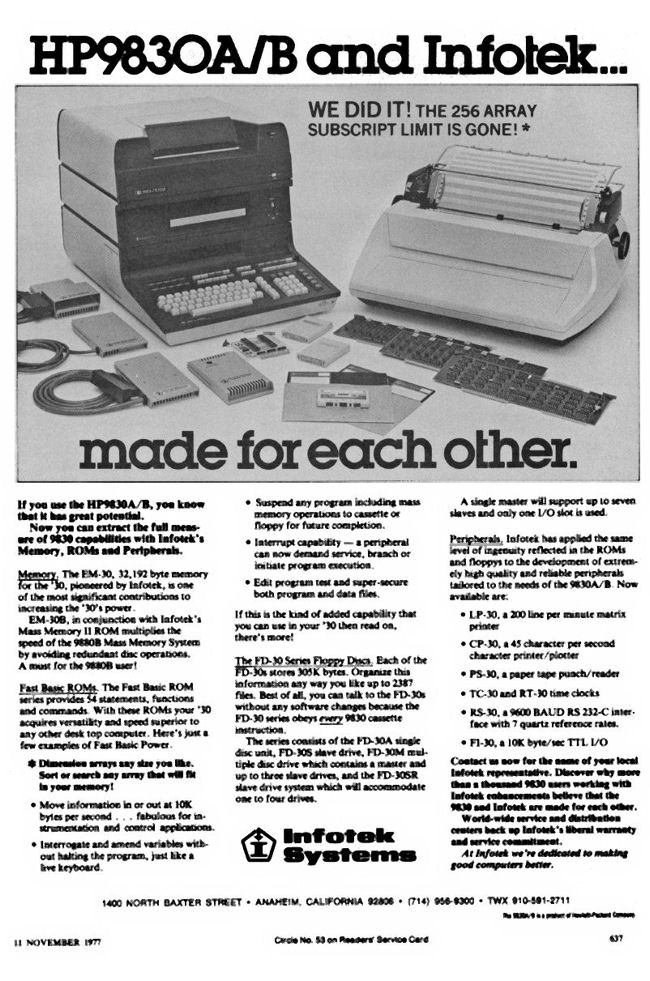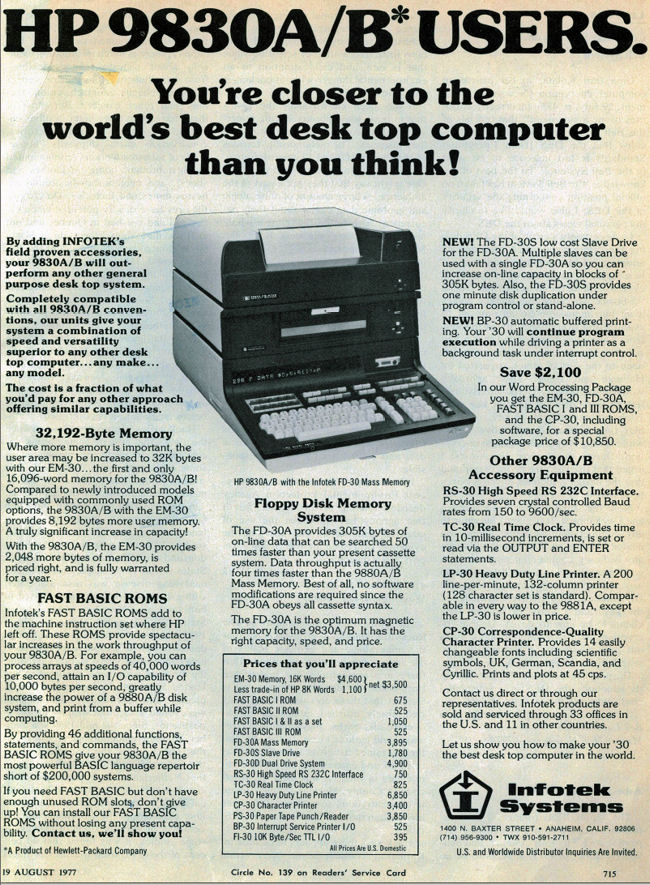|
|||||||||||||||||||||
|
|
|
Revised 5/4/06 |
|||||||||||||||||||||||
|
|
 |
||||||||||||||||||||||
|
The Infotek Story: Welcome to the (third) party
A very frustrated Kurzet telephoned HP Loveland but was pawned off on a factory sales engineer who politely listened to his proposals. The sales engineer then [incorrectly] told Kurzet that HP improved capabilities in subsequent models, not by meddling with existing ones. (Obviously, this salesperson didn’t understand how HP was tuning bits into gold by selling software in high-margin option ROMs.) Moreover, said the sales engineer, if the capabilities Kurzet was requesting for the HP 9830 were generally useful, HP’s engineers would have already thought of them and would have incorporated them at the outset. Kurzet knew he was getting the classic runaround from the HP salespeople and most customers might have quit trying to help HP at this point. However, Kurzet wasn’t a typical customer. He was a successful engineer. He knew digital and wasn’t afraid to use that knowledge. In addition, he already owned an electronics manufacturing company. Plus, he was fiercely Polish and felt genetically predisposed not to give up. Besides, the HP sales engineer had royally pissed him off! Kurzet followed a favorite guiding principal, which is very simple but quite true: "Wherever there is misery there is money to be made!" He saw misery in the form of frustration with HP's resistance to good ideas that could improve the HP 9830. Kurzet figured that if he was frustrated, then countless other customers must share his frustration. Kurzet sensed was an unmet need and decided to meet that need by building and marketing the very same products that he’d asked HP to make. Guided by his vision for the HP 9830, Kurzet would transform his company into a thriving third-party supplier of products for HP’s 9800 series desktop computers and their descendents. In 1975, he spun this new business off from ALS and named the company Infotek Systems. Infotek was started in the same building that ALS occupied on Edna Place in Covina California. Both Infotek and ALS moved to Baxter in Anaheim during 1978, mainly due to the success of Infotek’s operations. An early Infotek product was a faster timing crystal that made the HP9830 run about 20% faster than the stock speed. Stan knew that HP engineers always over-designed their products in those days, by about a 25% tolerance. That was one reason why HP quality was legendary. Stan took advantage of that built-in potential by transforming the HP 9830’s hardware design margin into better performance. German Patents Prove Key Realizing that nothing could be done to the HP 9830’s ROM code in the absence of commented source code (which HP was unlikely to provide), Kurzet decided to check HP's 9830 patents. The US patents disclosed nothing useful but the German patents—due to a typically Teutonic obsession with detail in HP’s German operation at Bublingen that had filed the German version of the 9830 patent—disclosed the whole nine yards. They held a complete copy of the commented source code for the HP 9830’s operating system and Basic interpreter. About that time, Kurzet learned about a former HP computer science type named John Wolff who was working as the IT manager at a family-owned company in Los Angeles that operated private clubs. The tip came from an HP System Engineer named Bob Stratton who worked out of the old HP-Neely sales office in North Hollywood. Wolff was reputed to be doing incredible things with stock HP 9830s by developing an accounts-receivable system on them for the clubs. Stratton told Kurzet that he thought that Kurzet and Wolff should get together. Kurzet did call Wolff, introduced himself, and tried to see if there could be some benefit to working together. That first call lasted about an hour and a half (not including bathroom breaks). Wolff had worked for HP in the software development lab of the Data Systems Division in Cupertino from 1968 thru 1974 and he proved to be a superb coder , particularly for the HP 2116 minicomputer architecture that HP had used to develop the HP 9830's processor. He excelled at writing applications, which allowed him to better appreciate the types of commands that needed to be added to the HP 9830’s Basic. Wolff’s ability to write extremely efficient machine code (for the option ROMs) allowed him to cram an incredible amount of horsepower into Infotek’s first language product: the Fast Basic I ROM. By the time Kurzet sold Infotek, there were five Fast Basic ROMs. On average, each ROM added a dozen or so statements, functions, and commands to the machine's Basic language repertoire. Wolff would drive from downtown Los Angeles to Kurzet's company in Covina (later Anaheim) after work, several nights each week, to work on the Fast Basic ROM products. He would arrive at about 6:00 pm. Usually the first order of business was for Wolff and Kurzet to have dinner at a great steak house where they enjoyed a culotte steak and scotch. Then they would return to the plant where Wolff would work until midnight. John Wolff also developed Infotek’s pentagonal logo, which added a fifth side to the boxed-arrow logo HP was using for the 9800 series desktop calculators and computers. Infotek’s sales slogan was something like “Adding a new dimension to the 9830,” and the logo reflected that thought. Corny, perhaps, but apropos. Wolff wrote all of Infotek’s Fast Basic ROMs as a freelance contractor and was paid a flat royalty for each ROM sold. Wolff is still works at his family’s company in Los Angeles, where he has been Vice President/CIO for more than 31 years. The company’s two HP 9830s still occupy a place of honor in the Data Center. The machines still work, although they have been retired since 1986. Another problem that constantly plagued Wolff when writing code for the HP 9830A was its limited RAM space. The base machine came with 4 Kbytes of RAM, expandable to 15 Kbytes. It wasn’t enough. That limitation created another opportunity for Infotek. The job of exploiting that opportunity fell to Larry Traylor, who reverse engineered the HP 9830A schematics using some memory read/write routines written by Wolff and a Biomation 1650 logic analyzer. The result was a 3-board set called the Infotek EM-30, which replaced some of the boards in the HP 9830A and boosted its RAM capacity to 32 Kbytes. HP eventually followed with the HP 9830B that also had the larger memory capacity. Better Mass Storage for the HP 9830 If the HP 9830 had an Achilles’ heel, it was the cassette drive used for storing programs and data. It was painfully slow (as were all of HP’s tape drives), capacity limited, and mechanically unreliable. In short, it was an aggravation. Particularly to Kurzet, who loved it when HP’s designs had serious problems because they harbor big opportunity. To solve this problem, Infotek developed the FD-30, an 8-inch floppy drive based on the Shugart disk-drive mechanism. The FD-30 and Infotek’s early 9830 memory boards were designed by Larry Traylor, who also helped Wolff reverse engineer the HP 9830’s ROM interface so that Infotek could produce the Fast Basic ROMs. The Shugart drive fit into a specially designed case that fit like meat in a sandwich between the HP 9830 and the HP 9866 thermal printer. Infotek couldn't make FD30s fast enough for the first year. The company sold thousands of them. The key to the FD30’s success was that it emulated the HP 9830’s cassette drive, so it was transparent to existing software. Infotek packaged the FD30 so that you had to look very closely to discover that it had not been manufactured by HP.
Shortly after introducing the first Fast Basic ROM, Infotek introduced RAM boards for the HP 9830. By that time 4-Kbit chips had become available. (HP wouldn’t use 4-Kbit RAM chips in a desktop calculator until 1976, when the company introduced the HP 9825.) The original HP 9830 memory used 1-Kbit RAMs from Intel. It took an ocean of them to make one of the HP 9830’s 8-Kbyte memory boards. The Infotek RAM board was about 60% cheaper than HP’s product. Infotek sold a ton of these boards and made a fortune on them—about a kilobuck per 8K. By this time HP Loveland was aware of Infotek and started to be concerned that customers would look to Infotek to enhance their HP 9830s instead of upgrading to HP's newer products. In fact, HP became sufficiently concerned that they actually flew a product manager out to California to see Kurzet. The product manager’s mission was to try and convince Kurzet that there was really no market for his add-on products because HP's new (and soon to be released) product line would obsolete them. By this time Infotek was already advertising in computer magazines. As soon as the HP product manager left, Kurzet called Wolff and told him what the HP product manager had said and the effort HP had made to convey the message. Kurzet's next act was to pick up the phone, call his advertising specialist, and say: "Double the ad budget, HP has just convinced me that the market is bigger than we thought." The Infotek ROM, floppy-disk drive, and memory boards were followed by the CP-30, an impact printer based on a domestically manufactured daisy-wheel printer that had a long platen like the HP (Facit) typewriter and a huge buffer, so that the HP 9830 could get on with its business while the CP30 printer clattered away. The CP-30 was also much faster and a great deal smarter than the Facit printer resold by HP. The single-drive FD-30 was followed by dual and triple floppy drives that could duplicate disks without help from the HP 9830 and included a 2-slot I/O expander built into the back of units. A lot of people bought the Infotek multiple-disk drives because of these extra features. One of the reasons Infotek added I/O expansion to the disk drives was because the company hade developed a real time clock called the RT-30. It used an I/O slot, so Infotek created extra slots. The RT-30 came with a ROM that added time and calendar functions to the HP 9830's version of Basic. Infotek also introduced a faster serial interface cable and the company’s crown jewel, a fast processor upgrade kit for the HP 9830. By 1977, Infotek offered a rather large line of HP 9830 add-on products.
Juicing the ‘30 The HP 9830 employed a processor that had been modeled on the processor in the 16-bit HP 2116 minicomputer. The HP 9830 had a 16-bit processor, but the processing took place serially, one bit at a time. Consequently, the HP 9830 was a relatively slow machine, especially compared to the HP 9100, HP’s first desktop calculator, which essentially had a highly parallel, 64-bit processor designed by Tom Osborne. Infotek took advantage of the four or five years of rapid IC development that had occurred since Chuck Near developed the original HP 9830 processor using simple TTL parts. Engineers working for Infotek designed a replacement for the HP 9830 processor using four 4-bit AMD 2901s—bit-slice processor chips—to create a 16-bit parallel processor that implemented the HP 9830 processor’s instruction set. The resulting 2-board product was called the Infotek MX-30. It was a lot faster than HP’s original design. Infotek introduced the MX-30 around the time that HP introduced the HP 9845, which was in April, 1978. The MX-30 made the old HP 9830 a hair faster than the new, dual-processor HP 9845. Conversion from the HP 9830’s original 1-bit serial processor to Infotek’s MX-30 processor took about 5 minutes. You popped open the HP 9830, unplugged a half dozen HP boards, plugged in the two Infotek MX-30 boards, screwed the lid back onto the machine, and powered up. Beyond a nominal order-of-magnitude speed increase, the MX30 had room for eight option ROMs, leaving the 3 internal and 5 external option-ROM slots in the HP 9830 available for further additions. Infotek priced the MX-30 upgrade kit at a quarter of the price for a barebones HP 9845. They sold a bunch. The brilliant engineers who developed the MX-30 were Bernie Braffman and Allan Roberts on hardware and Lee Aydelot who wrote some of the code. The MX-30 design team had to reverse engineer the HP 9830 down to the last detail so that the board exchange would work without making any modifications to the existing HP 9830 motherboard. The MX-30 design team finished the job in less than a year. Braffman and Roberts were Stanford MSEEs and Aydelot had an MS CS from Cal Tech. Showdown at the Trade Show In 1977, Infotek opened an office in Frankfurt, Germany to function as a sales and service center for Europe. The fellow in charge was Theo Stevens, a Dutch former HP sales engineer who speaks French, Dutch, English and German. In 1978 or 1979, Infotek exhibited at what was probably the biggest trade show in Europe, which was held every spring in Frankfurt. That’s where Infotek introduced the MX-30. A workstation product manager from HP Bublingen learned of the imminent introduction and prepared a benchmark program to test the MX-30. He brought the program to the show on an HP 9830 cassette, planning to visit the Infotek exhibit to debunk the absurd claim that the Infotek MX-30 made the HP 9830 about 10 times faster. The product manager arrived at the Infotek booth with an entourage of a half dozen subordinates in tow. After introductions and some small talk, he asked to be allowed to run his program “to give the MX a try.” After it ran, the program was supposed to display the HP “lazy T” character (a sideways T also used on the HP 9825). The lazy T signaled that the machine was waiting for another command. This test program required use of a stop watch to time the program’s execution. On a stock HP 9830, the program ran in about 8 seconds. While looking at his stopwatch, the HP product manager hit the run key on the MX-30-enhanced HP 9830. He then looked up at the display and saw the lazy T. Assuming that the HP 9830 hadn’t done anything, he exclaimed, “Hah! Das ist not verkink.” Kurzet assured him it was. The program had run a series of calculations so Kurzet suggested that the HP manager look at the declared variable holding the final result of the calculations, which would still be resident in the desktop calculator. When he did so, the product manager’s only comment was “Mine Gott!” At that point, the forewarned Kurzet handed the manager a partial roll of toilet paper he had flattened and hidden in his back pocket beforehand. The HP manager was a good sport and laughed along with everyone else. Everyone retired to the bar for a few beers and a discussion of what HP might do in the next generation of workstations. In 1978 or 1979, Infotek jumped into the HP 9845 market although the company did not do much with the newer and bigger desktop computer. Infotek’s products for the HP 9845 were limited to memory boards and a couple of ROMs including a spreadsheet ROM that “made the Lotus of the day look sophomoric” according to Kurzet. The company then turned its attention to the 68000-based HP 9000 Model 200, 300, and 400 series. It made RAM boards for these machines with four times the density per board than those available from HP. It also produced a powerful compiler and floating-point co-processor that made the Model 300 scream. Close on the heels of the compiler came the AD200 12-bit, 16-channel, 333 ksamples/sec A-to-D card and DIO digital I/O cards that plugged directly into the HP 9000 bus. The End of Infotek Kurzet sold Infotek and ALS in 1984. A.L.S. continued to be preeminent in the field of power conversion. Navy contracts kept ALS going and it is now part of L-3 Communications’ Power Systems Group. Sadly, Infotek was gone by 1987. The company did not survive the loss of Kurzet’s drive and insight. However, some of Infotek’s products appear to live on. Kurzet recruited John Haney for Infotek in 1982. Although his degrees were actually in math and law, Haney served as Infotek’s Chief Engineer from 1982 until the company shut down in 1987. He reverse engineers the HP 9845 so that Infotek could make memory boards and ROMs for that machine and he developed the memory and coprocessor cards for the HP 9000 model 200 and 300 machines. Haney incorporated Newport Digital in 1988 and, as of 2008, the company still lists memory cards for early HP 9000 workstations on its Web site (www.newportdigital.com). Kurzet did all of the above without a college education. He picked up electronics as a hobby at age 12 and repaired radios during World War II. The Marine Corps sent Kurzet to the Navy's ET (electronics technician) school in Great Lakes, Illinois and later to the equipment school in San Diego. He holds a Commercial Pilot's Instrument, Multiengine Airplane, and Helicopter ratings as well as a Lear Jet Captain rating. Kurzet bought his first airplane in 1956 and has been using personal planes to get him to his customers and for personal travel ever since, which leads to the story of Kurzet vs. the IRS. But that story belongs on someone else’s Web site (like this one). Notes: All information on this page comes from email exhanges and telephone conversations with Stan Kurzet and John Wolff, who also supplied the scans of the Infotek product manuals. Additional information and corrections came from Larry Traylor, who went on to found Arium (now American Arium), a pioneer in logic analysis and in-circuit emulation.
|
|||||||||||||||||||||||
|
| [Home] [Prehistoric Times] [The 9100 Project] [Prologues] [The 9825 Projects] [Epilogues] |

